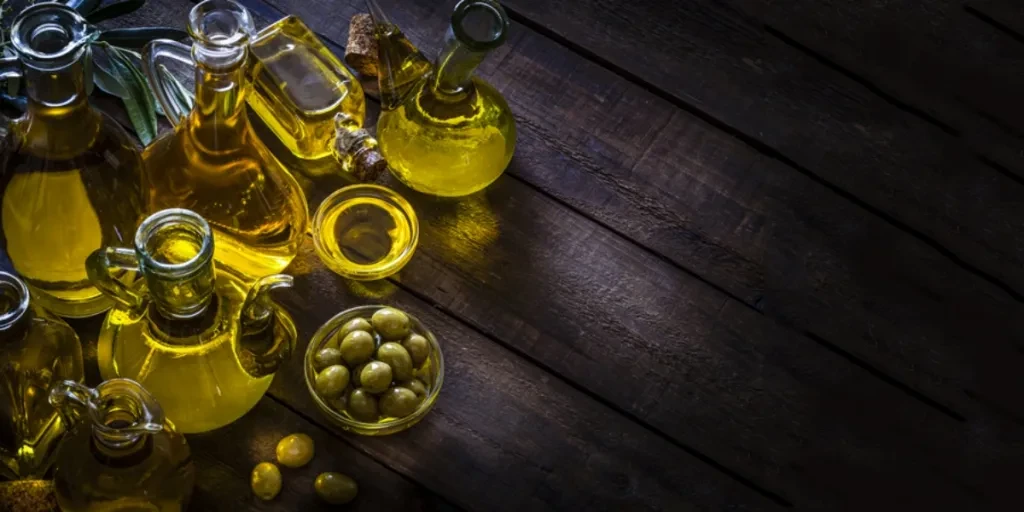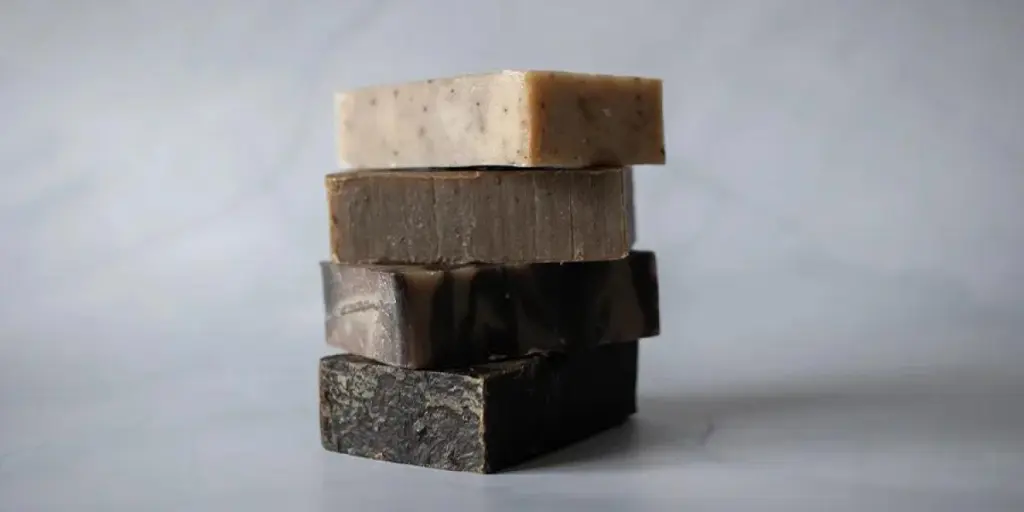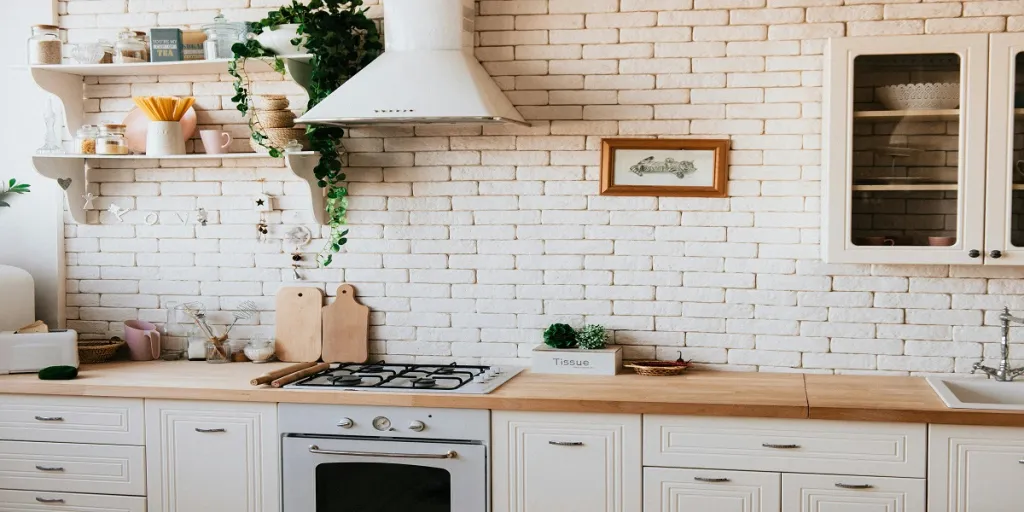Whether drizzling olive oil over a salad or storing it away for later use, knowing how to choose the right olive oil bottle is crucial. Each type of oil bottle is designed to ensure better control when pouring, freshness, and ease of use, but not all of them can be used effectively in all types of kitchen situations.
Keep reading to find out how to choose the best olive oil bottle for the kitchen, including the key features of each bottle and the downsides to take into account.
Table of Contents
How should olive oil be stored to maintain its quality?
Market value of oil bottles and Google search trends
How to choose the best olive oil bottle by material
Dark glass
Clear glass
Ceramic
Plastic
Final thoughts
How should olive oil be stored to maintain its quality?
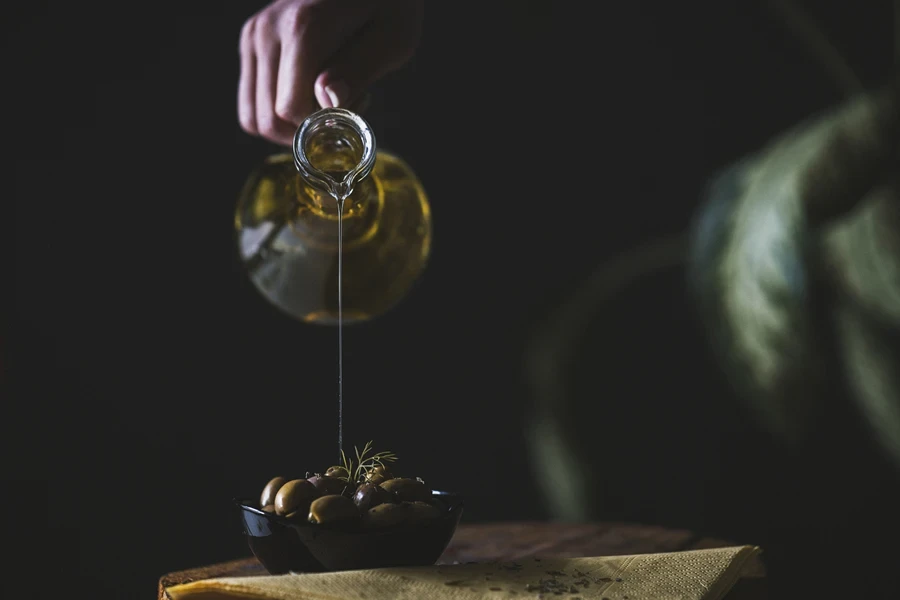
Olive oil is essential for cooking good-quality food, so it’s important to know how to store it. It needs to be kept in a cool and dark place, between 57°F and 70°F, to protect it from heat, air, and light. Ideally, a place such as a cupboard or pantry should be used so the oil is kept away from direct sunlight and cooking appliances.
The container needs to be made from materials that shield it from light, such as dark-tinted glass, but clear containers can be used if it’s being stored fully away from any light source and if the oil is being used on a regular basis.
Olive oil needs to be kept away from heat because it speeds up oxidation, and this can lead to the oil becoming rancid. Exposure to air can also be a problem as the oxygen will cause oil to break down over a period of time, which will make it lose its nutritional value and flavor. This is why it’s so important to ensure the oil bottle is tightly sealed, and it’s also why experts recommend using bottles with a narrow spout to limit air contact.
On the other end of the spectrum, cold temperatures can cause the olive oil to become cloudy, and while this doesn’t harm the oil, it can lead to changes in texture. This type of oil shouldn’t be put in plastic containers for long-term storage purposes unless they are food-grade or designed for oils specifically. This is because some plastics can react with the oil or leach chemicals.
Market value of oil bottles and Google search trends
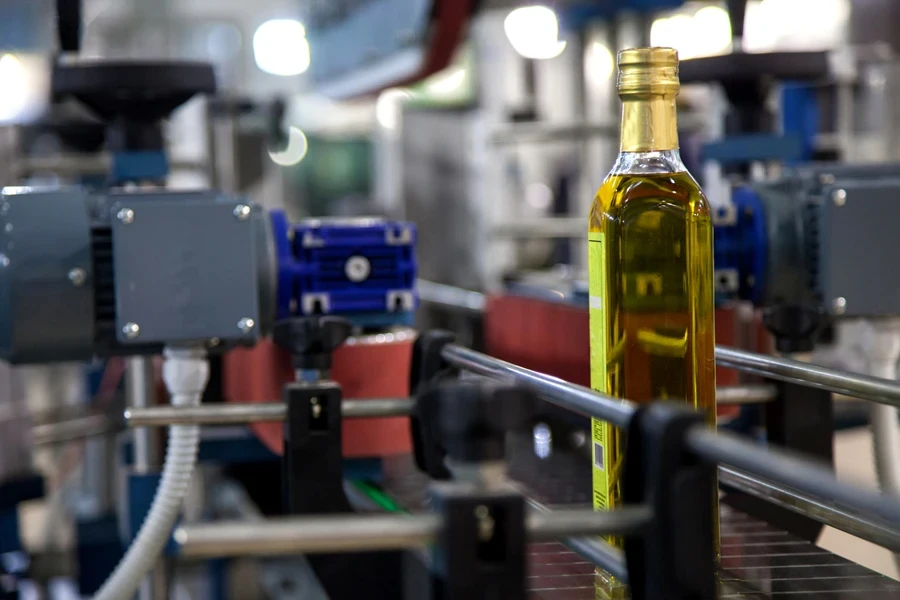
The global market value of oil bottles exceeded USD 2.25 billion by the end of 2024. This number is expected to increase by a compound annual growth rate (CAGR) of 4.98% between 2025 and 2033. This will bring the total market value up to approximately USD 3.56 billion by the end of this period.
With more people aiming to adopt a healthier lifestyle, the demand for oil bottle dispensers for high-quality oils such as olive oil and avocado oil is on the rise. Glass oil bottles currently hold the highest market share due to their appearance, sustainability, and because glass doesn’t react to oil in the same way other materials might.
In terms of online search trends, Google Ads shows that “oil bottle” received an average monthly search volume of 40,500 in 2024. The only drop in searches came in March and May, when they fell to 33,100 each month. For the remainder of the year, however, online searches remained very consistent.
How to choose the best olive oil bottle by material
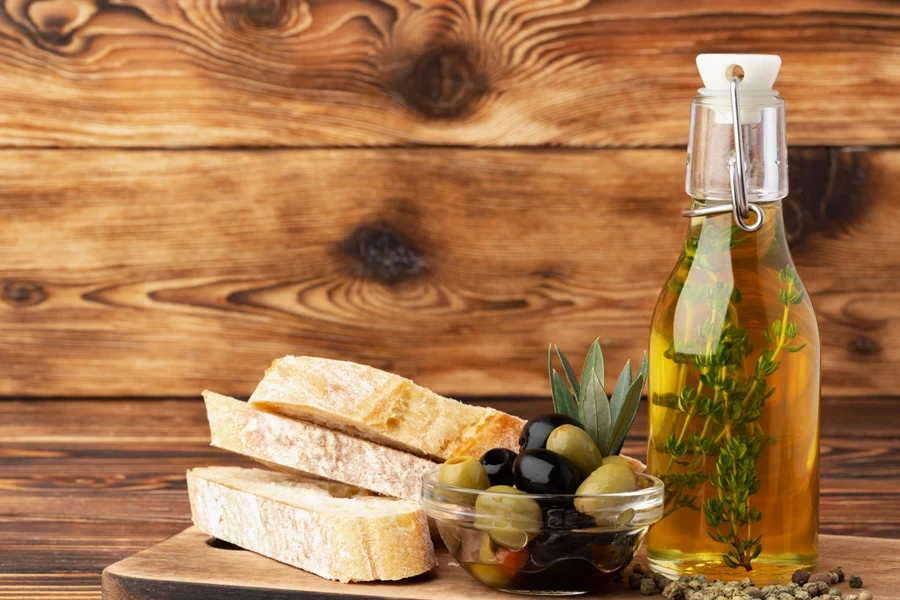
There are a few options that potential customers have concerning the materials used to store olive oil. Each type of oil bottle comes with its own set of advantages, but there are some trade-offs as well that need to be put into consideration.
Dark glass
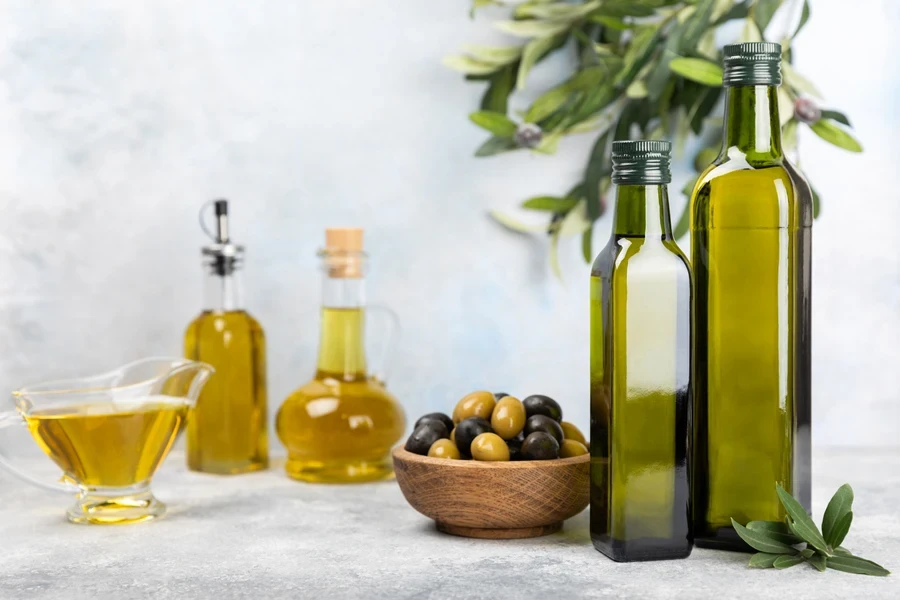
Dark glass olive oil bottles are generally tinted in amber or green. They’re regarded as an excellent choice for storing olive oil thanks to their ability to block out visible light as well as UV rays. They’re also the most popular option in most countries around the world.
The light filtration offered by dark glass reduces photooxidation, which is a process where light exposure degrades the antioxidants and phenolic compounds of the oil, and it accelerates the breakdown of lipids.
Using dark glass bottles helps to keep the flavor of olive oil in check, while preserving the nutritional values and aroma compounds of the oil as well. Another big draw to using dark glass bottles is that glass doesn’t create a negative interaction with the olive oil, so there’s no concern regarding chemical contamination or moisture buildup.
There are a few downsides to the purchase of dark glass bottles, however. The opacity of the bottles makes it difficult to see the level of the oil, which can be inconvenient for cooking professionals. Glass is also known for its fragility, so it’s more susceptible to breakage, especially in fast-paced environments like professional kitchens.
Clear glass
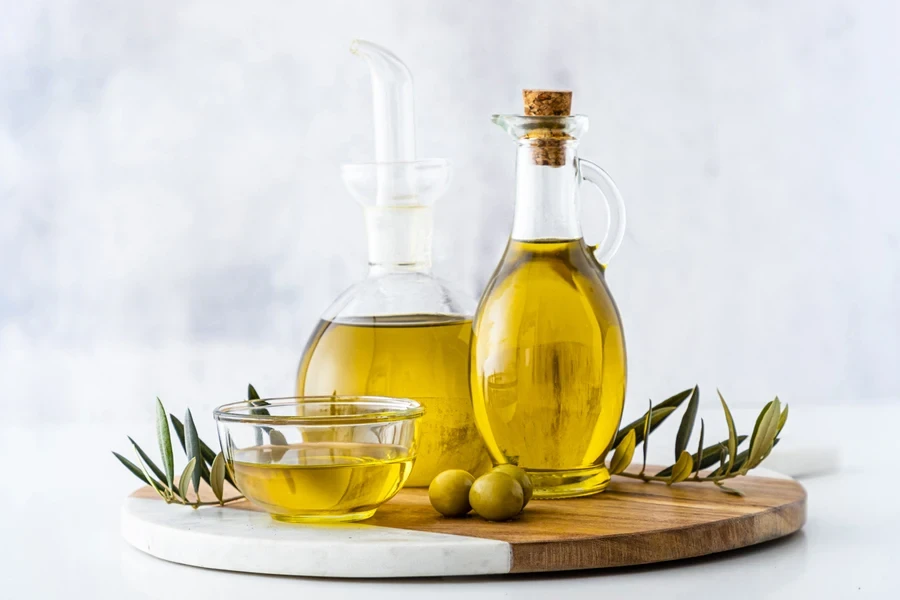
Clear glass olive oil bottles are the perfect choice for consumers who prioritize versatility and aesthetic appeal. This is one of the only materials that allows the user to see the current oil level without removing the lid, which allows for better pouring control and more timely refills. Clear glass is non-reactive so it won’t alter the chemical composition of the oil or the flavor.
This type of oil bottle is more likely to be used to enhance the visual appeal of a home kitchen or dining room, and often features a decorative spout to make the product look high-end. With so many shapes and sizes available, finding the perfect size comes down to the individual needs of the buyer.
The biggest downside to using clear glass olive oil dispensers is that it has no ability to protect the oil from outside light, which can accelerate oxidation and break down the oil’s essential compounds. This will reduce the shelf life of the olive oil, even if the oil is only exposed to light for a short period.
Ceramic
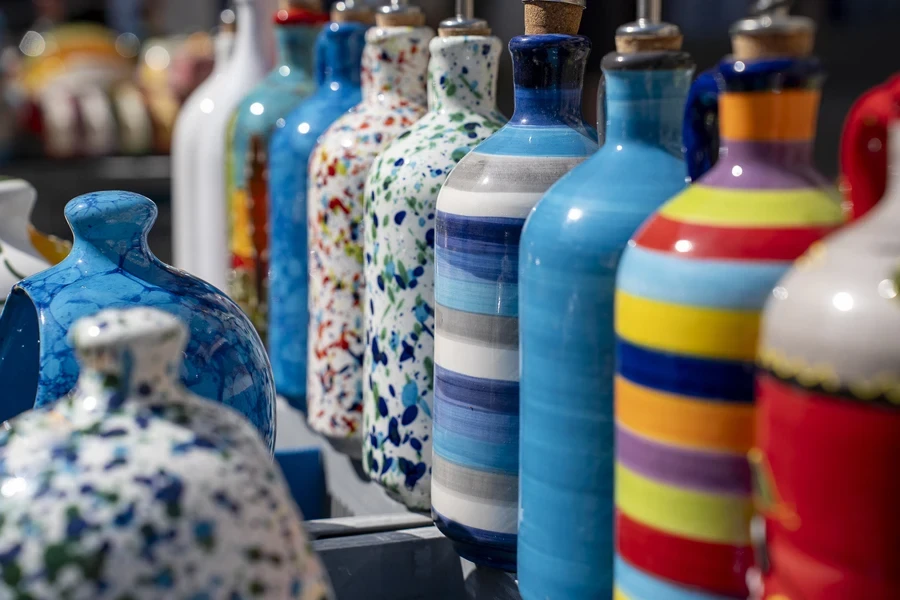
When storing olive oil, one of the most popular bottle choices is ceramic bottles. These bottles are very effective for blocking out visible light as well as UV light and preserving the bioactive compounds of the oil. Ceramic is another example of a non-reactive material that’s also non-porous when it’s glazed properly. This means the odors and flavors of the oil won’t be absorbed into the ceramic, making it perfect for maintaining the olive oil’s purity and overall profile.
This material has natural insulation properties so it’s ideal for regulating internal temperature fluctuations and protecting the oil against oxidation while in storage. Most ceramic olive oil bottles will feature a thin, narrow spout that’s attached to the opening of the bottle through a cork top to prevent too much air from going inside.
The selection of colors that these bottles are made in, as well as different designs, makes them the perfect oil dispenser for summertime or outdoor events. Ceramic bottles are available in different sizes, they’re dishwasher safe, and they can be used to store other items such as vinegar, water, and other liquids. They make the perfect addition to any kitchen decor, especially if they’re made-to-order pieces.
The downsides to using ceramic oil dispensers come from the practical side of things. Their opacity makes it impossible to see the amount of oil remaining inside, meaning the container needs to be opened regularly. Ceramic bottles are also significantly heavier than other materials, and they can be more fragile too, so careful handling is required to prevent damage. Another important thing to note is that ceramics are more expensive due to the craftsmanship involved, so they’re often seen as decorative kitchen accessories rather than utilitarian.
Plastic
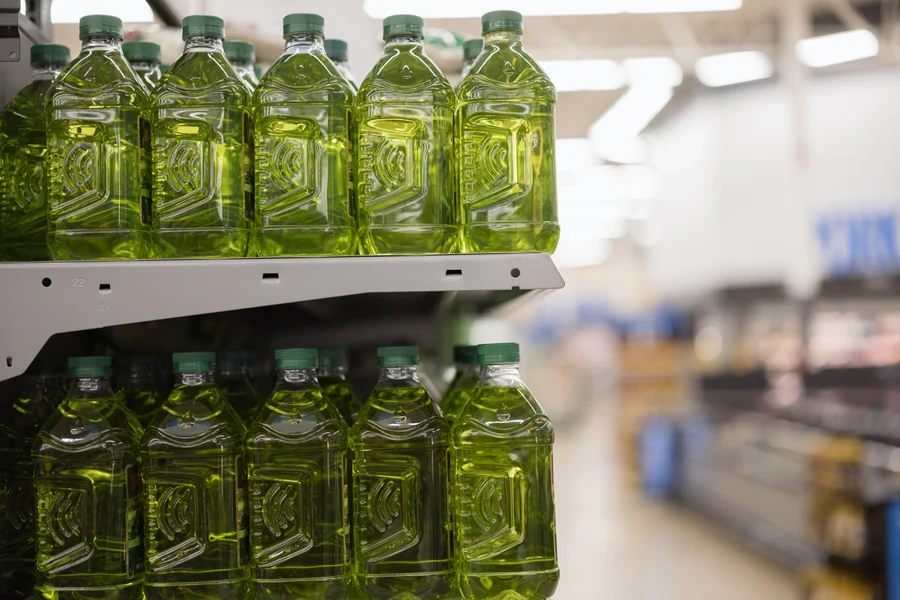
Plastic olive oil bottles are most commonly used for packaging due to their durable and lightweight properties. They’re made from either food-grade PET (polyethylene terephthalate) or HDPE (high-density polyethylene) to reduce the likelihood of chemical leaching.
These oil bottles are the perfect choice for storing large volumes of oil and for transportation, and some bottles are designed with a small amount of protection against outdoor lighting, so they’re acceptable for commercial and short-term use.
However, most plastics are semi-permeable, so over time, small amounts of air and light will penetrate the bottle. This will have a negative impact on the overall quality of the olive oil. Chemical leaching is also a big problem, especially when exposed to heat. Overall, plastic is best suited for temporary use, but it’s not a good option for preserving high-quality olive oil.
Final thoughts
Knowing how to choose the best olive oil bottle for different situations in the kitchen is key in order to preserve the oil and prevent spoilage from occurring. The three main types of materials include dark glass, clear glass, and ceramic, with plastic being a good option for commercial use or short-term storage. The important thing to remember is that olive oil needs to be kept in a cool, dark space to maintain its overall aroma, texture, and flavor.
